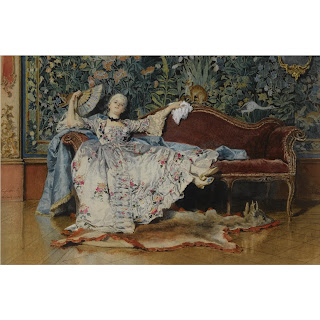It's been said that women speak more often than men—an average 20,000 words a day to the man’s 7,000. The figure’s disputed, but probably had more basis in the C18th and C19th when, but for the brief hiatus of the French Revolution, the ‘fan’ ruled in every fashionable salon. The phenomenon lent itself to satire:
“There is an infinite variety of motions to be made use of in the flutter of a fan. There is the angry flutter, the modish flutter, the timorous flutter, the confused flutter, the merry flutter, and the amorous flutter. Not to be tedious, there is scarce any emotion in the mind which does not produce a suitable agitation in the fan; insomuch, that if I only see the fan of a disciplined lady, I know very well whether she laughs, frowns or blushes. I have seen a fan so very angry, that it would have been dangerous for the absent lover who provoked it to have come with the wind of it, and at other times so very languishing, that I have been very glad for the lady’s sake the lover was at a sufficient distance from it...
(However) should any of my gentle readers desire to learn good news:
The fluttering of the fan is the last and indeed the masterpiece of the whole exercise; but if a lady does not misspend her time, she makes herself mistress of it in three months. I generally lay aside the dog-days and the hot time of the summer for the teaching this part of the exercise; for as soon as I pronounce ‘Flutter your fans’, the place is filled with so many zephyrs and gentle breezes as are very refreshing in that season of the year"
Joseph Addison The Spectator 1711
In the late C18th, two men, Charles Francis Badini and Robert Rowe, designed ‘communication hand fans.' Badini called his ‘Fanology or the Ladies Conversation Fan’ Rowe called his ‘The Ladies Telegraph, for Corresponding at a Distance.’ Printed instructions were written on the fans, and by all the angels and saints they were needed!
To give you a brief primer, holding the fan in the left hand and touching the right arm signified letters A to E
Conversely, holding the fan in the right hand and touching the left arm referred to the letters F – K. Touching the heart meant the letters L to P. And then there were the subdivisions, but I’ll stop before my brain melts.
Both sender and receiver would need razor-sharp and lightning-fast minds, the stress and mental anguish involved negating any thought of passion or romance. If this had been semaphore, the ship would have been sunk, the battle lost before the first sentence.
It’s hard to believe that any such language existed outside the minds of the men who conceived and designed these fluttering time-sucks, men with more time on their hands than sense.
But here’s the thing, other than ‘Mollies,’ men didn’t use fans, so they never got to answer back, never mind understanding what was being said to them. A perfect situation.
During the French Revolution fans lost their appeal especially amongst those fearing the guillotine. Frightened aristocrats would be scampering down streets thrusting them into the hands of the first peasant they saw.
After Napoleon’s fall and the Bourbon Restoration 1814 - 1830 there followed a fresh initiative in the use and language of fans. The best example was Duvelleroy, a fan maker and leather goods manufacturer; his firm founded in 1827 still exists.
Duvelleroy’s ‘fan language’ was relatively simple, one even I could master, though in the process I’d probably attract some wary glances from strangers, even some unwelcome advances.
Fans at the ready! After me! Here we go:
Carrying in the right hand in front of face = Follow me.
Carrying in the left hand in front of face= desirous of acquaintance
Placing it on left ear = I wish to get rid of you
Drawing it across forehead = You have changed.
Twirling in the left hand = we are watched
Carrying in the right hand = you are too willing
Drawing through the hand = I hate you.
Twirling in the right hand = I love another
Drawing across the cheek = I love you
Presented shut = Do you love me?
Drawing across the eyes = I am sorry
Touching tip with finger = I wish to speak with you
Letting it rest on the right cheek = yes
Letting it rest on the left cheek = No
Open and shut. – You are cruel
Dropping it – We will be friends
Fanning slowly = I am married
Fanning quickly = I am engaged
With handle to lips = kiss me
Open wide = wait for me
Carrying in left hand open = Come and talk to me
Placed besides the head = Don’t forget me
With little finger extended = Goodbye.
Alas, the day of the fan has gone and what an opportunity lost. I’d love to see them on TV doing signage for the deaf. The language is more limited perhaps and might convey less information, but it would be nicely erotic.
Here is a video for slow learners or those afraid of scaring the horses.



2 comments:
I've always enjoyed Lucy Worsley's docu-series.
Methinks Europeans had more time on their hands than the Japanese. I've never heard of them have a secret language, though they were fond of secret fan folding techniques.
As for women speaking more than men....not in my house. I rarely get a word in edgewise. But that's fine. I much prefer to listen.
Buy Greg a fan 😀
Post a Comment